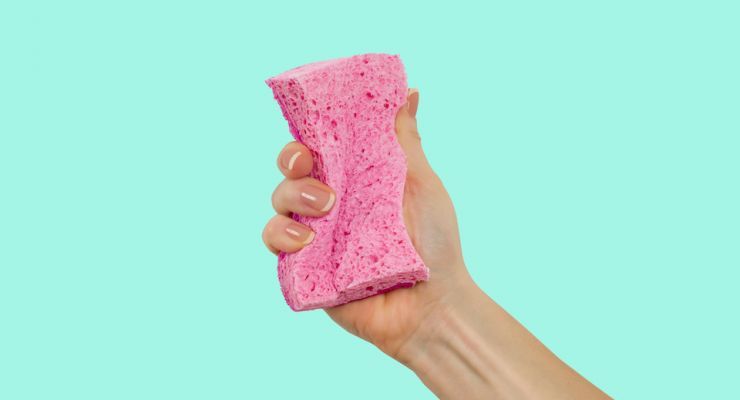Your trusty friend against that stuck on pasta sauce and your staunchest supporter in the fight for spotless drinking glasses. The kitchen sponge is your go-to tool for keeping a handle on that ever-growing pile of dishes in your sink and maintaining some level of control over your cooking oasis. However, sometimes the things we love can turn against us…It’s time to take a closer look at that sponge and find out just how often you should unwrap a new one. Hint: It’s more often than you think.
How often should you replace your sponge?
Experts recommend replacing your kitchen sponge every week if you wash dishes daily. If you eat out a lot (which can harm your health and your wallet), you may be able to stretch it for another week if you clean it properly.
Speaking of cleaning…it is imperative to keep your sponge clean and free of any nasty residue or food buildup that can lead to bacterial growth. Stick it on the top rack of the dishwasher each time you run it, or rinse it thoroughly in soap and hot water and stick it in the microwave for about two minutes to kill any lingering diseases. Remember, dry sponges can catch on fire in the microwave, so rinsing it beforehand is imperative. You can also soak it in a bleach, vinegar, and water solution overnight for a thorough clean, or if you don’t have a dishwasher.
There is some debate regarding the effectiveness of the microwave method, however. According to one study, nuking your sponge will kill some of the smaller, less harmful bacteria, but much of the larger, dangerous bacteria may thrive. Other studies indicate that efforts such as bleaching and microwaving, will only kill about 60% of the bacteria, which isn’t exactly reassuring. Take this into consideration before you clean your sponge and consider looking into alternative tools.
Why should you replace your kitchen sponge?
Scientists found a whopping 362 different species of living bacteria on just 14 sponges. If that wasn’t enough to freak you out, they also found 82 billion molecules of bacteria living in only one cubic inch of sponge. For comparison, that’s about the same density of bacteria you will find in a human stool sample. Gross!
Think about it; the kitchen is a hub of foot traffic, food bacteria, raw meat, and things like dirt and dust. Warm, wet sponges cling to nasty food gunk and are a breeding ground for bacteria such as E. coli and Salmonella. According to microbiologists, sponges are the most bacteria-ridden objects in your home…even more than the toilet.
Alternatives
Even though you’ve been using a sponge your entire life, it may be time to take a step back and reevaluate your options. Here are a few great alternatives to benefit the environment and protect your family from unwanted bacteria.
Dish brush
Plastic bristles, quick-drying design, long handle, what more could you ask for? The dish brush takes everything bad about the sponge and fixes it, giving you a useful tool and good peace of mind about the safety of your kitchen.
Dishcloths
Dishcloths aren’t necessarily any better at warding off bacteria than sponges; however, they are reusable and easier to clean which makes them an eco-friendly option. Plus, it will save you from having to remember to buy sponges at the store, and you can have a few on hand, which means that you can clean them more frequently. Simply toss them in the laundry with your whites and some bleach. Be sure to use hot water.
Plastic sponges
Not all sponges are equally as detrimental. Some are specifically designed to ward off bacteria and dry quickly. Look for plastic or another synthetic material with a fast-drying design.
Note: Though they are often neglected, the tools you use to clean your home need cleaned almost as often as the surfaces they are being used to clean. For instance, you should regularly clean the filters on your vacuum and replace mop heads or floor cleaning pads. Otherwise, the dirt and grime that they collect will simply transfer to other surfaces, and your cleaning will be pointless.
-Susan Patterson

